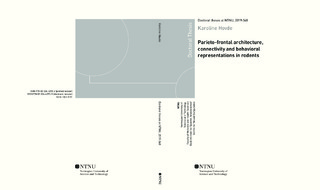| dc.contributor.advisor | Whitlock, Jonathan R. | |
| dc.contributor.advisor | Witter, Menno P. | |
| dc.contributor.author | Hovde, Karoline | |
| dc.date.accessioned | 2020-03-06T12:12:53Z | |
| dc.date.available | 2020-03-06T12:12:53Z | |
| dc.date.issued | 2019 | |
| dc.identifier.isbn | 978-82-326-4293-9 | |
| dc.identifier.issn | 1503-8181 | |
| dc.identifier.uri | http://hdl.handle.net/11250/2645787 | |
| dc.description.abstract | The posterior parietal cortex (PPC) and frontal motor cortices are important for a variety of cognitive processes including sensorimotor integration, decision-making, planning and execution goal-directed actions. Across mammals, PPC and frontal motor cortices are strongly connected and form the parietofrontal network, where ‘mirror’ neurons, perhaps the most famous example of sensorimotor integration, were first discovered in primates. Since rodents are serving an ever-greater role in studying the cellular mechanisms of cognitive processes in PPC and frontal cortical areas, the work in this thesis aims to describe the anatomical and functional properties of this network in both mice and rats. The first study in the thesis provides an anatomical description of the mouse PPC relative to the neighboring extrastriate areas, since PPC in mice is poorly defined, which confounds the interpretation of functional studies. I show that, like in rats, the mouse PPC is divided into anatomically distinguishable medial, lateral and posterior subdivisions (mPPC, lPPC and PtP, respectively), and that each of these areas partly overlaps with anterior aspects of multiple extrastriate areas. Second, I investigate whether the connections of rat PPC with frontal midline cortices are topographically organized as reported in primates. The results reveal that PPC is strongly connected with secondary motor cortex (M2) in a topographical manner, such that mPPC is preferentially connected with the most posterior portion of M2, whereas lPPC and PtP connect with the intermediate anterior-posterior portion. Connections with orbitofrontal cortex showed a medial-to-lateral trend, where mPPC preferentially connects with the medial half, including the medial and ventrolateral subregions. lPPC and PtP are preferentially connected with the medial and central portion of the ventrolateral orbitofrontal cortex. The topographical organization of connections with M2 indicates heterogeneity in both PPC and M2 in rodents, which prompts the final study in the thesis probing whether neurons in mouse M2 and PPC encode performed as well as observed actions like in primates. Using in vivo calcium imaging, we show that both M2 and PPC stably encode a variety of naturalistic behaviors when performed, but that such responses do not occur when the same animals observed the same behaviors being performed by another animal. In summary, I have (i) defined PPC anatomically in the mouse and (ii) shown that the rat PPC subregions are reciprocally connected with frontal midline cortices in a topographical manner, like in primates. (iii) In mice, neurons in M2 and PPC reliably encode performed but not observed behaviors, suggesting that that there are limits to the functional similarity of PPC and frontal cortices in rodents and primates. | |
| dc.language.iso | eng | nb_NO |
| dc.publisher | NTNU | nb_NO |
| dc.relation.ispartofseries | Doctoral theses at NTNU;2019:348 | |
| dc.relation.haspart | Paper 1:
Hovde, Karoline; Gianatti, Michele; Witter, Menno; Whitlock, Jonathan.
Architecture and Organization of Mouse Posterior Parietal Cortex Relative to Extrastriate Areas. European Journal of Neuroscience 2018 s. 1-17
https://doi.org/10.1111/ejn.14280
© 2018 Federation of European Neuroscience Societies and John Wiley & Sons Ltd | |
| dc.relation.haspart | Paper 2:
Olsen, Grethe Mari; Hovde, Karoline; Kondo, Hideki; Sakshaug, Teri; Haaland Sømme, Hanna; Whitlock, Jonathan; Witter, Menno.
Organization of Posterior Parietal–Frontal Connections in the Rat. Frontiers in Systems Neuroscience 2019 ;Volum 13.(38)
https://doi.org/10.3389/fnsys.2019.00038
This is an open-access article distributed under the terms of the Creative Commons Attribution License (CC BY). | |
| dc.relation.haspart | Paper 3:
ombaz, Tuce; Dunn, Benjamin Adric; Hovde, Karoline; Cubero, Ryan John Abat; Mimica, Bartul; Mamidanna, Pranav; Roudi, Yasser; Whitlock, Jonathan.
Action representation in the mouse parieto-frontal network.
BioRxiv 2019, doi.org/10.1101/646414
- Published in Scientific Reports 2020 ;Volum 10.(1) s. 1-14
https://doi.org/10.1038/s41598-020-62089-6
This is an open-access article distributed under the terms of the Creative Commons Attribution License (CC BY). | |
| dc.title | Parieto-frontal architecture, connectivity and behavioral representations in rodents | nb_NO |
| dc.type | Doctoral thesis | nb_NO |
| dc.subject.nsi | VDP::Medical disciplines: 700 | nb_NO |
